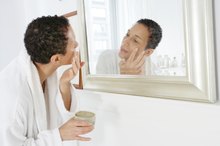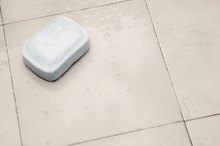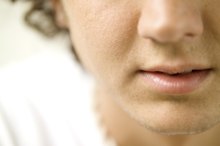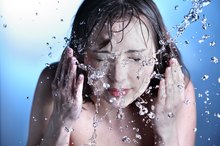What does fact checked mean?
At Healthfully, we strive to deliver objective content that is accurate and up-to-date. Our team periodically reviews articles in order to ensure content quality. The sources cited below consist of evidence from peer-reviewed journals, prominent medical organizations, academic associations, and government data.
- Journal of Cutaneous and Aesthetic Surgery: Prevention of Complications in Chemical Peeling
- Journal of Cutaneous and Aesthetic Surgery: Prevention of Complications in Chemical Peeling
The information contained on this site is for informational purposes only, and should not be used as a substitute for the advice of a professional health care provider. Please check with the appropriate physician regarding health questions and concerns. Although we strive to deliver accurate and up-to-date information, no guarantee to that effect is made.
Redness After a Chemical Peel
A chemical peel can be an effective skin care treatment to help with fine lines, wrinkles, acne, hyperpigmentation and other skin concerns 2. However, it is a potent treatment, usually done in a dermatologist’s office, so it can leave your skin a little tender afterward. In particular, you will likely suffer from post-peel redness for several days. You can keep the redness under control, though, if you care for your skin in the right way before and after your peel.
Causes of Redness
Along with peeling and dryness, redness is the main side effect of a medical grade chemical peel. In most cases, your face resembles a sunburn after the treatment. That is because the chemical agents used for the peel cause a controlled destruction of several layers of the skin so that new skin beneath is revealed with improved tone and texture. With the controlled injury, the skin’s tissues are left stressed or traumatized, which results in redness. The redness can last anywhere from several days to several weeks, depending on how sensitive or reactive your skin is.
- Along with peeling and dryness, redness is the main side effect of a medical grade chemical peel.
- With the controlled injury, the skin’s tissues are left stressed or traumatized, which results in redness.
Pre-Peel Care
How to Reduce Redness After a Chemical Peel
Learn More
To limit redness in your skin following your peel, take precautions beforehand. You should not bleach, wax or use a depilatory to remove facial hair in the week before your peel because these treatments can leave your skin more sensitive. Avoid harsh facial scrubs and masks as well. If you use a retinoid product, discontinue use approximately three days before your peel. Retinoids speed up cell turnover, so using it close to when you are scheduled for a peel can leave your skin tender.
- To limit redness in your skin following your peel, take precautions beforehand.
- If you use a retinoid product, discontinue use approximately three days before your peel.
Post-Peel Care
When your skin is red following a peel, use gentle products and keep your skin moist to avoid irritating it further. Wash with a mild soap-free cleanser, gently patting it on the face and rinsing with lukewarm water. When drying off your face, pat your skin with a towel instead of rubbing. The other key is regular application of moisturizer. You should not allow your skin to become dry because dryness can pull on the new skin underneath, causing additional redness and irritation. Apply your moisturizer as often as 10 to 20 times a day. Your doctor may also prescribe an antibiotic ointment to use if any crusting or scabbing occurs.
- When your skin is red following a peel, use gentle products and keep your skin moist to avoid irritating it further.
Sun Safety
How to Reduce Redness With Retin-A
Learn More
In first few days following your chemical peel, avoid sun exposure. A chemical peel thins your skin so you’re more vulnerable to the sun’s rays, which can increase redness. Approximately three days after your peel, you can begin to use sunscreen to protect your skin when you are outside. However, you should use a wide-brimmed hat and avoid the sun between the hours of 10 and 4 when it is at its strongest.
- In first few days following your chemical peel, avoid sun exposure.
- Approximately three days after your peel, you can begin to use sunscreen to protect your skin when you are outside.
Related Articles
References
- Journal of Cutaneous and Aesthetic Surgery: Prevention of Complications in Chemical Peeling
- New Beauty: Chemical Peels -- Post-Treatment Care
- O'connor AA, Lowe PM, Shumack S, Lim AC. Chemical peels: a review of current practice. Australas J Dermatol. 2018;59(3):171-181. doi:10.1111/ajd.12715
- Castillo DE, Keri JE. Chemical peels in the treatment of acne: patient selection and perspectives. Clin Cosmet Investig Dermatol. 2018;11:365–372. doi:10.2147/CCID.S137788
- Soleymani T, Lanoue J, Rahman Z. A practical approach to chemical peels: a review of fundamentals and step-by-step algorithmic protocol for treatment. J Clin Aesthet Dermatol. 2018;11(8):21–28.
- Cleveland Clinic. Chemical peels: what to expect.
- Cleveland Clinic. Chemical peels: how to prepare.
- Stanford Healthcare. Techniques: our approach to chemical skin peels.
- Cleveland Clinic. What results can I expect?.
Writer Bio
Based in New York City, Jennifer Blair has been covering all things home and garden since 2001. Her writing has appeared on BobVila.com, World Lifestyle, and House Logic. Blair holds a Bachelor of Arts in Writing Seminars from the Johns Hopkins University in Baltimore, Maryland.









